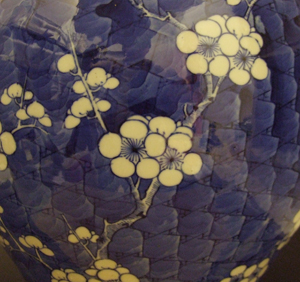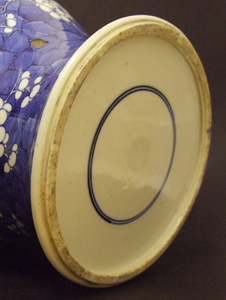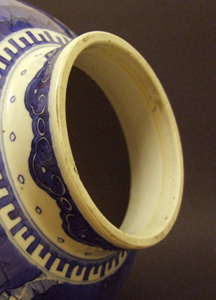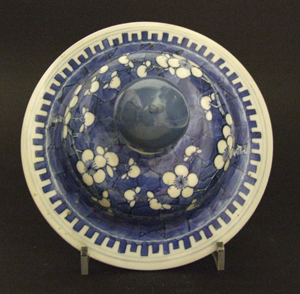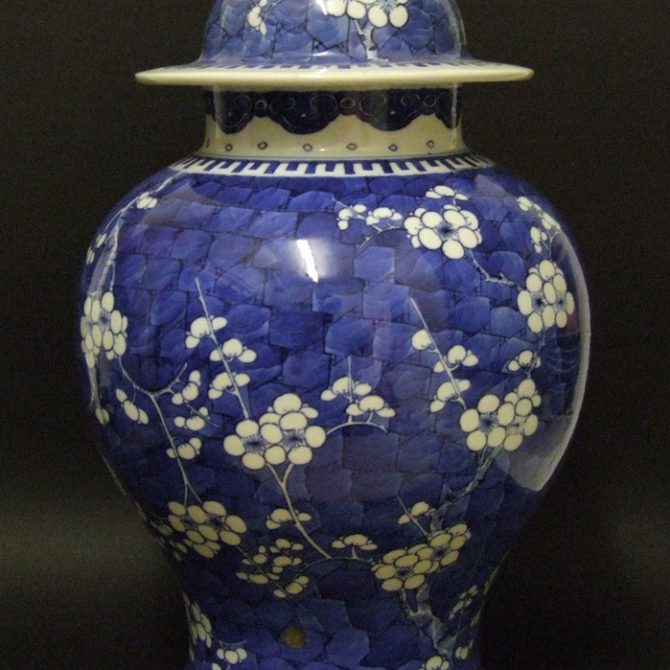
KANGXI 1662 – 1722 Chinese Export Porcelain
A Kangxi Blue and White Porcelain Baluster Jar and Cover, 1690-1720. This Large Chinese Export Porcelain Jar and Cover is Decorated in a Rich Vibrant Cobalt Blue with Large Branches of Prunus Set Against a Cracked Ice-Ground.
SOLD
- Condition
- The base has a large hole where it was probably fitted for electricity, there is a crack across the hole. There a glaze losses to the body as a result of a burst bubble and a smaller kiln scar.
- Size
- Height : 45 cm (17 3/4 inches)
- Provenance
- N/A
- Stock number
- 21918
- References
- For very similar Kangxi blue and white baluster jar and cover which we purchased from the same source in North America see our `Sold` stock, stock number 21772. For other example of `hawthorn jars` of varying types see : Kang-Hsi by Von Walter Bondy, Berlin 1923, plate 111. Also see : Chinese Blue and White Porcelain (Duncan Macintosh, Antique Collectors` Club,1977. ISBN 1-85149-210-0) page 109, plate 74. For a further three Kangxi blue and white porcelain jars of this type see : Chinese Porcelain (W.G. Gulland, Chapman & Hall, 1928) items 247, 248 and 249.
Information
Plum and Cracked-Ice, `Hawthorn` Jars :
Plum Meihua is one of the most important plants in Chinese art. Their flowers grow on knurled old angular branches, the flowers are fragile and pure, so they can be a symbol of vigour in old age as well as purity. The tree is the first to flower after the long hard winter, symbolically it can represent perseverance as well as renewal. This meaning is enhanced by a background of cracked-ice, the design can be seen as representing the end of winter and the beginning of spring with the ice of winter cracking to reveal a new year dawning. Branches of plum blossom convey the `Five Blessings` Meikai wufu, longevity, wealth, health, love of virtue and a peaceful death. The number five, an auspicious number to the Chinese, is taken in this design from the five petals of the plum flower. The design can be shown as single plum blossom flowers scattered over cracked-ice or flowering plum blossom branches against the cracked surface of the ice. Jars, especially the so-called ginger-jars or Hawthorn jars , decorated with this design were very popular in England during the end of the 19th and the early years of the 20th century. Kangxi blue and white porcelain in general was highly sought after at the time. It was made famous by the artist Whistler among others, and it became a symbol of the Aesthetic movement in England and North America. Prices for this type of Chinese blue and white porcelain, in real terms, reached far more than it would do today. For example the famous H.C. Huth `Hawthorn` jar and cover. This `ginger jar` was sold in Bristol in the 1860`s for 12s.6d and was then purchased by H.C. Huth in the 1880`s for £25. By order of his executors it was sold in Christie`s at King Street in London on the 17th of May 1905 for the staggering price of £5,900 to F.Partridge. It was purchased, again from Christie`s, by Spink and Son on November 1974, they bought it for a private English collector. It`s latest outing was also at Christie`s King Street, this time on the 7th of April 1997, selling for £24,000. To have reached the equivalent of the £5,900 paid in 1905, the jar would have had to have sold for around £340,000 (source ; the National Archives Currency Converter). Chinese porcelain prices have, like all luxury commodities, been governed by demand generated by fashion, availability and unfortunately market manipulation as well.
